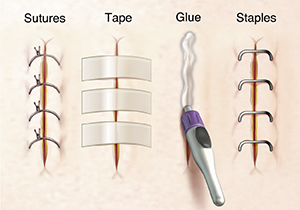Incision Care
Reminder
Keep all your follow-up visits. They let your healthcare provider make sure your incision is healing well.
Keep in mind that there are many types of bandages, tapes, and supplies. Follow the specific instructions from your healthcare team.
Ask for phone numbers to call if you need help.
Healthcare provider phone number: ________________________________
Home care
Tips for home care include:
-
Always wash your hands with soap and clean, running water and dry them before touching your incision.
-
Keep your incision clean and dry. Don't put creams or ointments on it unless directed by your healthcare team.
-
Don't do things that could cause dirt or sweat to get on your incision.
-
Don’t pick at scabs. They help protect the wound.
-
Keep your incision dry and out of water, as instructed by your healthcare team. Follow your provider's specific instructions on when to bathe or shower. You may be advised to take a sponge bath to prevent getting your incision wet.
-
If you're instructed to keep your incision out of water, follow your provider's instructions about the best way to keep your incision dry when bathing or showering.
-
Pat stitches dry if they get wet. Don’t rub.
-
Leave the bandage (dressing) in place until you're told to remove it or change it. Change it only as directed, using clean hands.
-
After the first 12 hours, change your dressing every 24 hours, or as directed by your provider.
-
Change your dressing if it gets wet or dirty.
Care for types of closures
Follow these guidelines:
-
Stitches (sutures) or staples. Once you no longer need to keep these dry, clean the wound each day. First remove the bandage using clean hands. Then wash the area gently with soap and clean, running water. Pat stitches dry. Finally, put on a new bandage.
-
Skin glue. Don’t put liquid, ointment, or cream on your wound while the glue is in place. Don't do activities that cause heavy sweating. Protect the wound from sunlight. Don't scratch, rub, or pick at the glue. Don't put tape directly over the glue. The glue should peel off in 5 to 10 days.
-
Surgical tape. Keep the area dry. If it gets wet, blot the area dry with a clean towel. Surgical tape often falls off in 7 to 10 days. If it hasn't fallen off after 10 days, contact your healthcare provider before taking it off yourself. If you're told to remove the tape, put mineral oil or petroleum jelly on a cotton ball. Gently rub the tape until it's removed.

Changing your dressing
Leave the dressing (bandage) in place until you're told to remove it or change it. Follow the instructions below unless told otherwise by your healthcare provider:
-
Always wash your hands before changing your dressing.
-
After the first 48 hours, the incision wound often will have sealed. If it has, follow your provider's directions. They may advise you to uncover the incision and leave it open to the air. If the incision hasn't sealed, keep it covered.
-
Cover your incision only if your clothing is rubbing it or causing irritation, or if it's still draining.
-
Change your dressing if it gets wet or dirty.
Follow-up care
Follow up with your healthcare provider to ask how long stitches or staples should be left in place. Return for stitch or staple removal as directed. If dissolving stitches were used in an area, such as your mouth, these may not need to be removed. They should fall out or dissolve on their own.
If tape closures haven't fallen off on their own, remove them yourself when your provider advises.
If skin glue was used, the glue will wear off by itself.
When to call your healthcare provider
Call your healthcare provider if you have any of these:
-
Pain, redness, swelling, or bleeding that gets worse
-
Smelly fluid from the incision, or changes in color of the drainage from the incision
-
Fever of 100.4°F ( 38 ºC) or higher, or as advised
-
Shaking or chills
-
Upset stomach (nausea) or vomiting that doesn't go away
-
Numbness, coldness, or tingling around the incision
-
Changes in skin color around the incision
-
The wound opens
-
Stitches that pull apart
-
Staples that fall out
-
Surgical tape that falls off before 7 days
Online Medical Reviewer:
Chris Southard RN
Online Medical Reviewer:
Marianne Fraser MSN RN
Online Medical Reviewer:
Melinda Murray Ratini DO
Date Last Reviewed:
3/1/2024
© 2000-2024 The StayWell Company, LLC. All rights reserved. This information is not intended as a substitute for professional medical care. Always follow your healthcare professional's instructions.